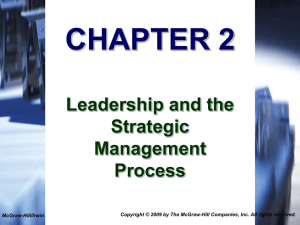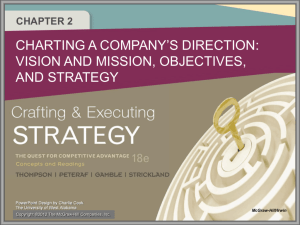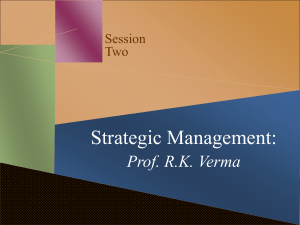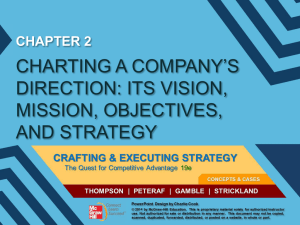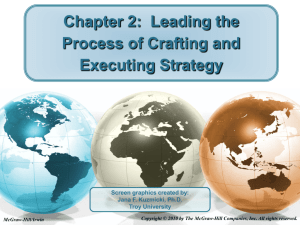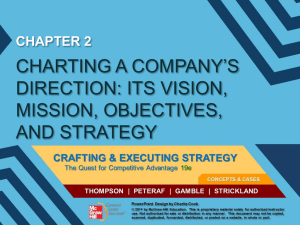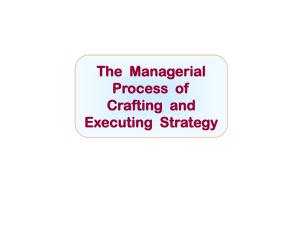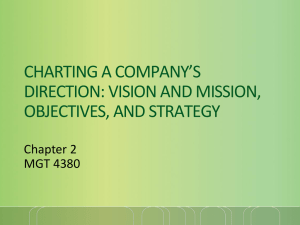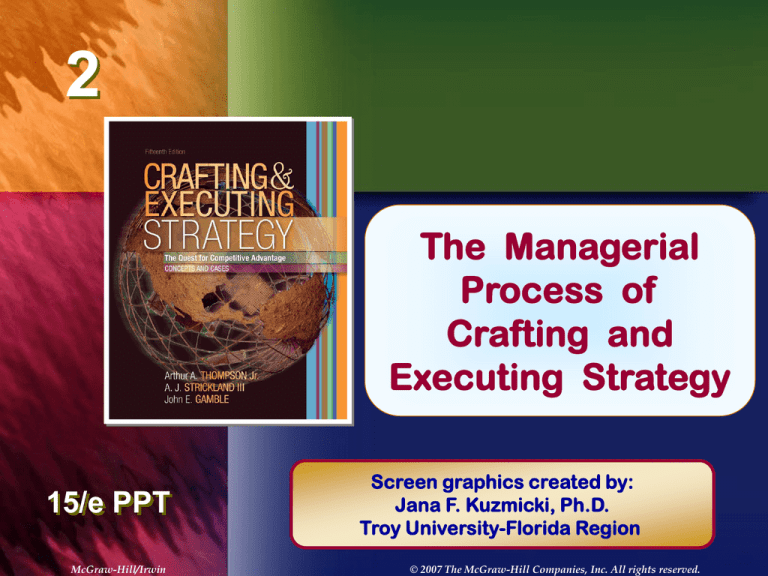
2
The Managerial
Chapter Title
Process of
Crafting and
Executing Strategy
15/e PPT
McGraw-Hill/Irwin
Screen graphics created by:
Jana F. Kuzmicki, Ph.D.
Troy University-Florida Region
© 2007 The McGraw-Hill Companies, Inc. All rights reserved.
“If you don’t know where
you are going, any road
will take you there.”
The Koran
2-2
“Management’s job is not to
see the company as it is
. . . but as it can become.”
John W. Teets
2-3
Chapter Roadmap
What Does the Process of Crafting and Executing Strategy Entail?
Developing a Strategic Vision: Phase 1 of the Strategy-Making,
Strategy-Executing Process
Setting Objectives: Phase 2 of the Strategy-Making, StrategyExecuting Process
Crafting a Strategy: Phase 3 of the Strategy-Making, StrategyExecuting Process
Implementing and Executing the Strategy: Phase 4 of the
Strategy-Making, Strategy-Executing Process
Initiating Corrective Adjustments: Phase 5 of the StrategyMaking, Strategy-Executing Process
Corporate Governance: The Role of the Board of Directors in the
Strategy-Making, Strategy-Executing Process
2-4
Fig. 2.1: The Strategy-Making, Strategy-Executing Process
2-5
Developing a Strategic Vision
Phase 1 of the Strategy-Making Process
Involves
thinking strategically about
Future direction of company
Changes in company’s product/market/customer
technology to improve
Current market position
Future prospects
A strategic vision describes the route a company
intends to take in developing and strengthening
its business. It lays out the company’s strategic
course in preparing for the future.
2-6
2-7
Key Elements of a Strategic Vision
Delineates management’s aspirations for the business
Provides a panoramic view of “where we are going”
Charts a strategic path
Is distinctive and specific to
a particular organization
Avoids use of generic language that is dull
and boring and that could apply to most
any company
Captures the emotions of employees
and steers them in a common
direction
Is challenging and a bit beyond a
company’s immediate reach
2-8
Role of a Strategic Vision
A well-conceived and well-communicated vision functions as
a valuable managerial tool to
Give the organization a sense of direction, mold organizational
identity, and create a committed enterprise
Inform company personnel and other stakeholders what
management wants its business to look like and “where we are
going”
Spur company personnel to action
Provide managers with a reference point to
Make strategic decisions
Translate the vision into hard-edged objectives
and strategies
Prepare the company for the future
A strategic vision exists only as words and has no organizational impact unless
and until it wins the commitment of company personnel and energizes them to
act in ways that move the company along the intended strategic path!
2-9
2-10
2-11
Examples of Strategic Visions
Red Hat
To extend our position as the most trusted Linux and open
source provider to the enterprise. We intend to grow the
market for Linux through a complete range of enterprise
Red Hat Linux software, a powerful Internet management
platform, and associated support and services.
Wells Fargo
We want to satisfy all of our customers’ financial needs,
help them success financially, be the premier provider
of financial services in every one of our markets, and
be known as one of America’s great companies.
2-12
Examples of Strategic Visions
Hilton Hotels Corporation
Our vision is to be the first choice of the world’s
travelers. Hilton intends to build on the rich heritage
and strength of our brands by:
Consistently delighting our customers
Investing in our team members
Delivering innovative products and services
Continuously improving performance
Increasing shareholder value
Creating a culture of pride
Strengthening the loyalty of our constituents.
2-13
Examples of Strategic Visions
Dental Products Division
of 3M Corporation
Become THE supplier of choice to the global dental
professional markets, providing world-class quality and
innovative products. [All employees of the division
wear badges bearing these words, and when- ever a
new product or business procedure is being
considered, management asks “Is this representative of
THE leading dental company?”]
Caterpillar
Be the global leader in customer value.
2-14
Examples of Strategic Visions
H. J. Heinz Company
Be the world’s premier food company, offering
nutritious, superior tasting foods to people
everywhere. Being the premier food company
does not mean being the biggest but it does
mean being the best in terms of consumer value,
customer service, employee talent, and
consistent and predictable growth.
eBay
Provide a global trading platform where practically
anyone can trade practically anything.
2-15
Strategic Vision vs. Mission
A strategic vision
concerns a firm’s future
business path - “where
we are going”
Markets to be pursued
Future product/market/
customer/technology
focus
Kind of company
management is
trying to create
The mission statement of
a firm focuses on its
present business purpose
- “who we are and what
we do”
Current product and
service offerings
Customer needs being
served
Technological
and business
capabilities
2-16
Characteristics of a Mission Statement
Identifies
the boundaries of the current business
and highlights
Present products and services
Types of customers served
Geographic coverage
Conveys
Who we are,
What we do, and
Why we are here
A well-conceived mission statement distinguishes a company’s
business makeup from that of other profit-seeking enterprises in
language specific enough to give the company its own identify!
2-17
Key Elements of a Mission Statement
Three factors need to be identified
for completeness
Customer needs being met
What is being satisfied
Customer groups or markets being served
Who is being satisfied
What the organization does (in terms of business
approaches, technologies used, and activities performed)
to satisfy the target needs of the target customer groups
How customer needs are satisfied
A company’s mission is not to make a profit! Its true
mission is its answer to “What will we do to make a profit?”
Making is profit is an objective or intended outcome!
2-18
Trader Joe’s Mission Statement
(a unique grocery store chain)
To give our customers the best food and beverage
values that they can find anywhere and to provide
them with the information required for informed
buying decisions. We provide these with a dedication
to the highest quality of customer satisfaction
delivered with a sense of warmth, friendliness, fun,
individual pride, and company spirit.
2-19
Communicating the Strategic Vision
Winning
support for the vision involves
Putting “where we are going and why” in writing
Distributing the statement organization-wide
Having executives explain vision to the workforce
An
engaging, inspirational vision
Challenges and motivates workforce
Articulates a compelling case for where company is
headed
Evokes positive support and excitement
Arouses a committed organizational
effort to move in a common direction
2-20
Examples: Vision Slogans
Levi Strauss & Company
“We will clothe the world by marketing the most
appealing and widely worn casual clothing in the world.”
Nike
“To bring innovation and inspiration
to every athlete in the world.
Mayo Clinic
“The best care to every patient every day.”
2-21
Examples: Vision Slogans
Scotland Yard
“To make London the safest major city in the world.”
Greenpeace
“To halt environmental abuse and
promote environmental solutions.”
Charles Schwab
“To provide customers with the most useful and
ethical financial services in the world.”
2-22
Overcoming Resistance to
a New Strategic Vision
Mobilizing
support for a new vision entails
Reiterating basis for the new direction
Addressing employee concerns head-on
Calming fears
Lifting spirits
Providing updates and progress
reports as events unfold
2-23
Test Your Knowledge
The difference between a company's mission statement and the
concept of a strategic vision is that
A. the mission statement lays out the desire to make a profit, whereas the
strategic vision addresses what strategy the company will employ in
trying to make a profit.
B. a mission statement deals with “where we are headed ” whereas a
strategic vision provides the critical answer to “how will we get
there?”
C. a mission deals with what a company is trying to do and a vision
concerns what a company ought to do.
D. a mission statement typically concerns an enterprise’s present
business scope and purpose—“who we are, what we do, and why we
are here”—whereas the focus of a strategic vision is on the direction
the company is headed and what its future product-customer-markettechnology focus will be.
E. a mission is about what to accomplish for shareholders whereas a
strategic vision concerns what to accomplish for customers.
2-24
Recognizing Strategic Inflection Points
Sometimes
an order-of-magnitude change occurs
in a company’s environment that
Dramatically alters its future prospects
Mandates radical revision of its strategic course
Critical
decisions have to be made about where to
go from here
A major new directional path may have to be taken
A major new strategy may be needed
Responding
quickly to unfolding changes in the
marketplace lessons a company’s chances of
Becoming trapped in a stagnant business or
Letting attractive new growth opportunities slip away
2-25
Intel’s “Strategic
Inflection Points”
Prior
to mid-1980s
Focus on memory chips
Starting
in mid-1980s
Abandon memory chip business (due to lower-cost
Japanese companies taking over the market) and
Become preeminent supplier of microprocessors to PC industry
Make PC central appliance in
workplace and home
Be undisputed leader in driving
PC technology forward
1998
Shift focus from PC technology to becoming the
preeminent building block supplier to Internet economy
2-26
Payoffs of a Clear Strategic Vision
Crystallizes
Reduces
an organization’s long-term direction
risk of rudderless decision-making
Creates
a committed enterprise
where organizational members
enthusiastically pursue efforts to
make the vision a reality
Provides
a beacon to keep strategy-related
actions of all managers on common path
Helps
an organization prepare for the future
2-27
Linking the Vision with Company Values
Companies often develop a statement of values to guide a company’s
pursuit of its vision and strategy and paint the white lines for how the
company’s business is to be conducted
Company values statements typically
contain four to eight beliefs, traits, and
behaviors relating to such things as
Integrity, doing the right thing, product quality,
customer satisfaction, treatment of people,
teamwork, operating excellence,
giving back to the community
But values statements remain a bunch of nice words until
the espoused beliefs, traits, and behaviors
Are incorporated into company’s operations and work practices
Are used as the benchmark for job appraisal, promotions, and rewards
If company personnel are not held accountable
for displaying company values in doing their jobs, then the
company values statement is an empty box!
2-28
Example: Company Values
Kodak
Respect for the dignity of the individual
Uncompromising integrity
Unquestioned trust
Constant credibility
Continual improvement and personal renewal
Open celebration of individual and team achievements
2-29
Example: Company Values
Home Depot
Creating
shareholder value
Entrepreneurial
spirit
Building strong
relationships
Excellent
customer service
Giving back to the
community
Taking care of
people
Respect for all
people
Doing the right
thing
2-30
Example: Company Values
Du Pont
Safety
Ethics
Respect for
people
Environmental
stewardship
2-31
Example: Company Values
Heinz
Passion . . . to be passionate about winning and about our brands, products
and people, thereby delivering superior value to our shareholders.
Risk Tolerance . . . to create a culture where entrepreneurship and prudent
risk taking are encouraged and rewarded.
Excellence . . . to be the best in quality and in everything we do.
Motivation . . . to celebrate success, recognizing and rewarding the
achievements of individuals and teams.
Innovation . . . to innovate in everything, from products to processes.
Empowerment . . . to empower our talented people to take the initiative and to
do what’s right.
Respect . . . to act with integrity and respect towards all.
2-32
Setting Objectives
Phase 2 of the Strategy-Making Process
Purpose
of setting objectives
Converts vision into specific performance targets
Creates yardsticks to track performance
Well-stated
objectives are
Quantifiable
Measurable
Contain a deadline for achievement
Spell-out
how much of what kind
of performance by when
2-33
Importance of Setting Stretch Objectives
Objectives
should be set at levels that
stretch an organization to
Perform at its full potential,
delivering the best possible results
Push firm to be more inventive
Exhibit more urgency to improve its business position
Be intentional and focused in its actions
There’s no better way to avoid ho-hum results than
by setting stretch objectives and using compensation
incentives to motivate organization members to
achieve the stretch performance targets!
2-34
Types of Objectives Required
Financial Objectives
Strategic Objectives
Outcomes focused
on improving financial
performance
Outcomes focused on
improving competitive
vitality and future
business position
$
2-35
Examples: Financial
Objectives
X
% increase in annual revenues
X % increase annually in after-tax profits
X % increase annually in earnings per share
Annual dividend increases of X %
Profit margins of X %
X % return on capital employed (ROCE)
Increased shareholder value
Strong bond and credit ratings
Sufficient internal cash flows to fund 100% of new
capital investment
Stable earnings during periods of recession
2-36
Examples: Strategic
Objectives
Winning an X % market share
Achieving lower overall costs than rivals
Overtaking key competitors on product performance or
quality or customer service
Deriving X % of revenues from sale of new products
introduced in past 5 years
Achieving technological leadership
Having better product selection than rivals
Strengthening company’s brand name appeal
Having stronger national or global sales and distribution
capabilities than rivals
Consistently getting new or improved products to market
ahead of rivals
2-37
Nissan’s Financial Objectives
Increase
sales to 4.2 million cars and trucks
by 2008 (up from 3 million in 2003)
Cut
purchasing costs 20% and halve the
number of suppliers
Have
zero net debt
Maintain
a return on invested capital of 20%
Maintain
a 10% or better operating margin
2-38
McDonald’s Financial
and Strategic Objectives
Place
more emphasis on delivering an
exceptional customer experience
Add approximately 350 net
new McDonald’s restaurants
Reduce general and administrative
spending as a percent of total revenues
Achievements
Systemwide sales and revenue growth of 3-5%
Annual operating income growth of 6-7%
Annual returns on incremental invested capital in high
teens
2-39
H. J. Heinz Company’s Financial
and Strategic Objectives
Achieve
4-6% sales growth, 7-10% growth in operating income, EPS in
the range of $2.35 to $2.45, and operating free cash flow of $900 million
to $1 billion in fiscal 2006
Pay
dividends equal to 45-50% of earnings
Increase
focus on company’s 15 power brands and give top resource
priority to those brands with number one and two market positions
Continue
to introduce new and improved food products
Add
to the Heinz portfolio of brands by acquiring
companies with brands that complement existing brands
Increase
sales in Russia, Indonesia, China, and India
by 50% in fiscal year 2006 to roughly 6% of total sales
By
end of fiscal 2008, derive approximately 50% of sales and profits
from North America, 30% from Europe, and 20% from all other markers
2-40
Seagate Technology’s Financial
and Strategic Objectives
Solidify the company’s No. 1 position in
the overall market for hard-disk drives
Get more Seagate drives into popular consumer
electronics products
Take share away from Western Digital in providing disk
drives for Microsoft’s Xbox
Maintain leadership in core markets and achieve
leadership in emerging markets
Grow revenues by 10% per year
Maintain gross margins of 24-26%
Hold internal operating expenses to 13-13.5% of revenue
2-41
3M Corporation’s Financial
and Strategic Objectives
To
achieve
Long term sales growth of 5-8% plus 2-4% from
acquisitions
Annual growth in earnings per share of 10% or better, on
average
A return on stockholders’ equity of 20-25%
A return on capital employed of 27% or better
Double
the number of qualified new 3M product ideas
and triple the value of products that win in the
marketplace
Build
the best sales and marketing organization in
the world
2-42
Test Your Knowledge
Which of the following represents the best example of a
well-stated strategic objective (as opposed to a well-stated
financial objective)?
A. Achieve revenue growth of 150% annually
B. Achieve a AA bond rating within 3 years and an annual cash
flow of $750 million
C. Invest more money in R&D to enable the company to offer
customers the widest selection of products in the industry
D. Increase market share from 15% to 20% and achieve the
lowest overall costs of any producer in the industry, both
within three years
E. Pay more attention to reducing costs over the next two years
2-43
For Discussion: Your Opinion
Which matters most to a company’s future financial
performance—setting and pursuing financial
performance targets or setting and pursuing strategic
performance targets?
What arguments support your answer?
2-44
Good Strategic Performance Is the Key
to Better Financial Performance
Achieving good financial performance is not enough
Current financial results are “lagging indicators” reflecting results
of past decisions and actions—good profitability now does not
translate into stronger capability for delivering even better
financial results later
However, meeting or beating strategic performance targets signals
Growing competitiveness
Growing strength in the marketplace
A company that is growing competitively stronger is developing
the capability for better financial performance in the years ahead
Good strategic performance is thus a “leading indicator” of a
company’s capability to deliver improved
future financial performance
Unless a company sets and achieves stretch
strategic objectives, it is not developing the
competitive muscle to deliver even better financial
results in the years ahead!
2-45
A Balanced Scorecard Approach –
Setting Strategic and Financial Objectives
A balanced scorecard for measuring
company performance is optimal; it entails
Setting financial and strategic objectives
Placing balanced emphasis on achieving
both types of objectives
(However, if a company’s financial performance is dismal or if its very
survival is in doubt because of poor financial results, then stressing the
achievement of the financial objectives and temporarily de-emphasizing
the strategic objectives may have merit)
Just tracking financial performance overlooks the
importance of measuring whether a company is
strengthening its competitiveness and market position.
The surest path to sustained future profitability year after
year is to relentlessly pursue strategic outcomes
that strengthen a company’s business position and
give it a growing competitive advantage over rivals!
2-46
Short-Term vs.
Long-Term Objectives
Short-term
objectives
Targets to be achieved soon
Milestones or stair steps for reaching long-range
performance
Long-term
objectives
Targets to be achieved within
3 to 5 years
Prompt actions now that will
permit reaching targeted
long-range performance later
2-47
Concept of Strategic Intent
A company exhibits strategic intent when
it relentlessly pursues an ambitious
strategic objective, concentrating the full
force of its resources and competitive
actions on achieving that objective!
2-48
Characteristics of Strategic Intent
Indicates firm’s intent to making quantum gains in
competing against key rivals and to establishing itself
as a winner in the marketplace, often against long odds
Involves establishing a grandiose performance target
out of proportion to immediate capabilities and market
position but then devoting a firm’s full resources and
energies to achieving the target over time
Signals relentless commitment to
achieving a particular market position
and competitive standing
2-49
Test Your Knowledge
A company pursues strategic intent when
A. it pursues its strategic vision.
B. it crafts a strategy and proceeds to implement it.
C. it adopts a strategic plan and tries to execute it.
D. it sets objectives and pursues their achievement.
E. it relentlessly pursues an ambitious strategic
objective and concentrates its full resources and
competitive actions on achieving that objective.
2-50
Objectives Are Needed at All Levels
The process is more top-down than bottom up
1. First, establish organization-wide objectives and
performance targets
2. Next, set business and
product line objectives
3. Then, establish functional
and departmental objectives
4. Individual objectives are established last
2-51
Importance of Top-Down Objectives
Provides
guidelines for objective-setting and
strategy-making in lower-level organizational units
Ensures
financial and strategic performance
targets for all business units, divisions, and
departments are directly connected to achieving
company-wide objectives
Top-down
objective-setting has two advantages
Leads to cohesive and compatible objectives
and strategies up and down the organization
Helps unify internal efforts to move
company along the chosen strategic path
2-52
Crafting a Strategy
Phase 3 of the Strategy-Making Process
Strategy-making
involves entrepreneurship
Actively searching for opportunities to do new things
or
Actively searching for opportunities to do
existing things in new or better ways
Strategizing
involves
Developing timely responses to happenings
in the external environment
and
Steering company activities in new directions dictated by
shifting market conditions
2-53
What Does Good Strategy Making Entail?
Masterful strategies come partly (maybe
mostly) by doing things differently
from competitors where it counts
Out-innovating them
Being more efficient
Being more imaginative
Adapting faster
Rather than running with the herd!
2-54
The Hows That
Define a Firm's Strategy
How
to grow the business
How
to please customers
How
to outcompete rivals
How
to respond to changing market conditions
Strategy
is HOW
to . . .
How
to manage each functional
piece of the business (R&D, production, marketing,
HR, finance, and so on)
How
to achieve targeted levels of performance
2-55
Who Participates in Crafting Strategy?
CEO (chief executive officer)
Senior executives
Has ultimate responsibility for leading the
strategy-making, strategy-executing process
Functions as strategic visionary and
chief architect of strategy
Typically exercise influential strategy-making roles
Lead efforts to fashion chief strategy components in their own areas
of responsibility
Managers of subsidiaries, divisions, plants, other important
operating units (and, often, key employees)
Brings on-the-scene people with detailed familiarity with local
competitive conditions and customer requirements/expectations into
the strategy-making process
2-56
Why Are Collaborative Efforts
Used in the Strategy-Making Process?
Many
strategic issues are complex or cut across
multiple areas of expertise
Ideas
of people with different expertise and
perspectives strengthen the strategizing effort
A team
effort in crafting the strategy,
especially a team that includes people
responsible for implementing it,
enhances motivation, commitment,
and accountability in executing the
strategy and making it work
2-57
For Discussion: Your Opinion
Crafting a company’s strategy is really a job for senior
executives and the company’s board of directors.
True or false? Discuss and explain.
2-58
Strategy-Making Role of
Corporate Intrapreneurs
Encouraging lower-level managers/employees to be good
entrepreneurs and join in on the strategy-making effort
Unleashes talents and energies of employees to brainstorm and
champion proposals for
New technologies or technological applications
New products or product lines
New business ventures
New strategic initiatives
Requires that senior executives
Provide organizational and budgetary support for worthwhile
proposals
Create an organizational climate where free-thinking and new ideas
are welcome
2-59
Fig. 2.1: A Company’s Strategy-Making Hierarchy
2-60
Tasks of Corporate Strategy
Moves
to achieve diversification
Actions
to boost performance of individual
businesses
Capturing
valuable cross-business synergies to
provide 1 + 1 = 3 effects!
Establishing
investment
priorities and steering
corporate resources into the
most attractive businesses
2-61
Tasks of Business Strategy
Initiating
approaches to produce successful
performance in a specific business
Crafting
competitive moves to build
sustainable competitive advantage
Developing
competitively valuable
competencies and capabilities
Uniting
strategic activities of functional areas
Gaining
approval of business strategies by
corporate-level officers and directors
2-62
Tasks of Functional Strategies
Game
plan for a strategically-relevant
function, activity, or business process
Detail
how key activities
will be managed
Provide
support for
business strategy
Specify
how functional objectives
are to be achieved
2-63
Tasks of Operating Strategies
Concern
narrow strategic approaches to manage
key operating units and strategically-relevant
operating activities
Add
detail to business
and functional strategies
Delegation
of responsibility
to frontline managers
2-64
Levels of Strategy-Making
in a Diversified Company
Corporate-Level
Managers
Corporate
Strategy
Two-Way Influence
Business-Level
Managers
Business Strategies
Two-Way Influence
Functional
Managers
Functional Strategies
Two-Way Influence
Operating
Managers
Operating Strategies
2-65
Levels of Strategy-Making in
a Single-Business Company
Business-Level
Managers
Business
Strategy
Two-Way Influence
Functional
Managers
Functional Strategies
Two-Way Influence
Operating
Managers
Operating Strategies
2-66
Test Your Knowledge
The strategy-making hierarchy in a single business
company consists of
A. it pursues business strategy, divisional strategies, and
departmental strategies.
B. business strategy, functional strategies, and operating
strategies, whereas in a diversified company it consists of
corporate strategy, business strategies (one for each business
the diversified company is in), functional strategies, and
operating strategies.
C. business strategy and operating strategy.
D. company strategy, divisional strategies, and functional
strategies.
E. corporate strategy, divisional strategies, and departmental
strategies.
2-67
Uniting the Company’s
Strategy-Making Effort
A firm’s
strategy is a collection of initiatives
undertaken by managers at all levels
in the organizational hierarchy
Pieces of strategy should fit
together like the pieces of a puzzle
Key approaches used to unify all strategic initiatives
into a cohesive, company-wide action plan
Effectively communicate company’s vision, objectives,
and major strategies to all personnel
Exercise due diligence in reviewing lower-level
strategies for consistency and support of higher-level
strategies
2-68
What Is a Strategic Plan?
Its strategic vision
and business mission
A
Company’s
Its strategic and
financial objectives
Strategic Plan
Consists of
Its strategy
2-69
Implementing and Executing Strategy
Phase 4 of the Strategy-Making Process
Operations-oriented
activity aimed at
performing core business activities in a
strategy-supportive manner
Tougher
and more time-consuming
than crafting strategy
Key
tasks include
Improving efficiency of strategy being executed
Showing measurable progress in achieving targeted
results
2-70
What Does Strategy Implementation Involve?
Building a capable organization
Allocating resources to strategy-critical activities
Establishing strategy-supportive policies
Instituting best practices and programs for
continuous improvement
Installing information, communication,|
and operating systems
Motivating people to pursue the target objectives
Tying rewards to achievement of results
Creating a strategy-supportive corporate culture
Exerting the leadership necessary to drive the process
forward and keep improving
2-71
Characteristics of Good Strategy Execution
Requires
Involves
diligent pursuit of operating excellence
a company’s entire management team
Hinges
on skills and cooperation
of operating mangers who
Push needed changes in their organizational units
Consistently deliver good results
Success
involves
Meeting or beating performance targets
Showing progress in achieving the strategic vision
2-72
Evaluating Performance and
Making Corrective Adjustments
Phase 5 of the Strategy-Making Process
Tasks
of crafting and implementing the strategy are
not a one-time exercise
Customer needs and competitive conditions change
New opportunities appear; technology
advances; any number of other
outside developments occur
One or more aspects of executing the
strategy may not be going well
New managers with different ideas take over
Organizational learning occurs
All
these trigger a need for corrective actions and
adjustments on an as-needed basis
2-73
Monitoring, Evaluating, and
Adjusting as Needed
Taking
actions to adjust to the march of events
tends to result in one or more of the following
Altering long-term direction and/or
redefining the mission/vision
Raising, lowering, or changing
performance objectives
Modifying the strategy
Improving strategy execution
2-74
Corporate Governance:
Strategic Role of a Board of Directors
Exercise
strong oversight to ensure five tasks of
strategic management are executed to benefit
Shareholders or
Stakeholders
Make
sure executive actions are not only proper
but also aligned with interests of stakeholders
2-75
Obligations of a Board of Directors
Be
inquiring critics and overseers
caliber of senior executives’ strategymaking and strategy-executing skills
Evaluate
Institute
a compensation plan for
top executives rewarding them for
results that serve interests of
Stakeholders and
Shareholders
a company’s
financial accounting
and reporting practices
Oversee
2-76
Key Roles of a Board of Directors
Be well informed about a company’s performance
Guide and judge CEO and other top executives
Exhibit courage to curb inappropriate or unduly risky
management actions
Certify to shareholders that CEO
is doing what board expects
Provide insight and advice to management
Intensely involved in debating pros and cons
of key actions and decisions
A board of directors has a very important oversight role
in the strategy-making, strategy-executing process!
2-77

